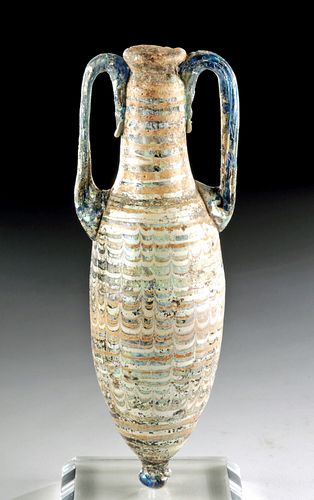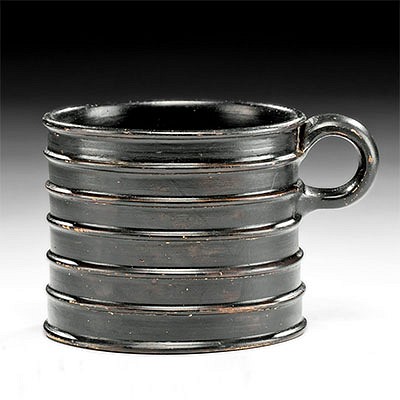Greek Hellenistic Core Formed Glass Amphoriskos
Lot 39b
About Seller
Artemis Gallery
686 S Taylor Ave, Ste 106
Louisville, CO 80027
United States
Selling antiquities, ancient and ethnographic art online since 1993, Artemis Gallery specializes in Classical Antiquities (Egyptian, Greek, Roman, Near Eastern), Asian, Pre-Columbian, African / Tribal / Oceanographic art. Our extensive inventory includes pottery, stone, metal, wood, glass and textil...Read more
Categories
Estimate:
$7,500 - $11,250
Absentee vs Live bid
Two ways to bid:
- Leave a max absentee bid and the platform will bid on your behalf up to your maximum bid during the live auction.
- Bid live during the auction and your bids will be submitted real-time to the auctioneer.
Bid Increments
| Price | Bid Increment |
|---|---|
| $0 | $25 |
| $300 | $50 |
| $1,000 | $100 |
| $2,000 | $250 |
| $5,000 | $500 |
| $10,000 | $1,000 |
| $20,000 | $2,500 |
| $50,000 | $5,000 |
| $100,000 | $10,000 |
| $200,000 | $20,000 |
About Auction
By Artemis Gallery
Mar 12, 2020
Set Reminder
2020-03-12 10:00:00
2020-03-12 10:00:00
America/New_York
Bidsquare
Bidsquare : Ancient / Ethnographic Around The World
https://www.bidsquare.com/auctions/artemis-gallery/ancient-ethnographic-around-the-world-4957
Ancient art from Egypt, Greece, Italy and the Near East, as well as Asian, Fossils, Pre-Columbian, Native American, African / Tribal / Oceanic, Spanish Colonial, Russian Icons, Fine art, much more! Artemis Gallery info@artemisgallery.com
Ancient art from Egypt, Greece, Italy and the Near East, as well as Asian, Fossils, Pre-Columbian, Native American, African / Tribal / Oceanic, Spanish Colonial, Russian Icons, Fine art, much more! Artemis Gallery info@artemisgallery.com
- Lot Description
Ancient Greece, Hellenistic Period, ca. 2nd to 1st century BCE. A stunning example of a core-formed glass amphoriskos once used to hold perfumed oil. The vessel boasts an elegant piriform body with a drop-shaped base, a sloped shoulder that tapers to form the cylindrical neck, a thick circular rim with an upturned lip to mitigate spillage, and a pair of high-arching trail handles made from sapphire-blue glass. The opaque light-blue body is decorated with strands of opaque white and yellow glass that have been feathered into an attractive pattern, and additional strands of un-feathered yellow glass create a ringed presentation around the neck. Fantastic layers of silvery and rainbow-hued iridescence have formed across all surfaces and gracefully accentuate this wonderful example of early Greek glass-making artistry! Size: 2.2" W x 6.1" H (5.6 cm x 15.5 cm); 6.6" H (16.8 cm) on included custom stand.
A vessel like this would have been made for the elites of ancient society. Its owner would have used a stopper to keep the contents inside, and a glass rod to dip into the vessel's perfumed oils and dab on the throat or wrists. The little handles made it possible to suspend the vessel, and we know from Athenian vase paintings that vessels like these could be worn off a belt at the waist or suspended from the wrist.
The Greeks created core-formed or sandcore vessels by trailing threads of molten glass over a "core" of sand or clay to form the vessel. These threads were oftentimes feathered or dragged to create intriguing decorative patterns. The term amphoriskos literally means "little amphora" and is indeed a miniature amphora. This shape was quite popular as it was ideal to store precious oils, perfumes, or cosmetics.
According to the Corning Museum of Glass, core forming is "the technique of forming a vessel by winding or gathering molten glass around a core supported by a rod. After forming, the object is removed from the rod and annealed. After annealing, the core is removed by scraping." (https://www.cmog.org/glass-dictionary/core-forming). This process of glass making was begun in the late 16th century BCE by glassmakers of Mesopotamia, and then adopted by Egyptian glassmakers in the 15th century BCE. The technique almost came to an end in the so-called Dark Ages of Mediterranean civilization (1200 to 900 BCE); however, by the 9th century BCE a new generation of glassmakers took up the technique once again, and between the 6th and 4th century BCE core-forming spread throughout the Mediterranean.
For a stylistically-similar example, please see The Metropolitan Museum of Art, accession number 17.194.597: https://www.metmuseum.org/art/collection/search/249831
Another stylistically-similar example, of a smaller size and with fewer colors, hammered for $11,875 at Christie's, New York Antiquities auction (sale 2007, June 4, 2008, lot 113): https://www.christies.com/lotfinder/ancient-art-antiquities/an-eastern-mediterranean-core-formed-glass-amphoriskos-circa-5078848-details.aspx?from=searchresults&intObjectID=5078848&sid=c6882591-ec34-4a8d-9d81-7ea910e285cc
Provenance: private East Coast, USA collection; ex-Martin J. Wunsch collection, New York, USA, acquired in the 1980s
All items legal to buy/sell under U.S. Statute covering cultural patrimony Code 2600, CHAPTER 14, and are guaranteed to be as described or your money back.
A Certificate of Authenticity will accompany all winning bids.
We ship worldwide and handle all shipping in-house for your convenience.
#147783Handles and neck repaired from multiple pieces, with small chips and resurfacing along break lines, and light restoration to small areas of neck. Minor abrasions and encrustations to body, neck, rim, and base, with minor chips to rim and base. Light earthen deposits as well as stunning silver and rainbow iridescence throughout. Old inventory label on verso of neck.Condition
- Shipping Info
-
All shipping is handled in-house for your convenience. Your invoice from Artemis Gallery will include shipping calculation instructions. If in doubt, please inquire BEFORE bidding for estimated shipping costs for individual items.
-
- Buyer's Premium



 EUR
EUR CAD
CAD AUD
AUD GBP
GBP MXN
MXN HKD
HKD CNY
CNY MYR
MYR SEK
SEK SGD
SGD CHF
CHF THB
THB














